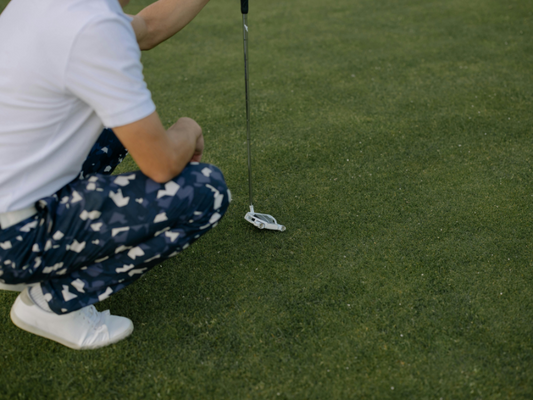I'll never forget watching a good buddy of mine walk out of the pro shop with a $400 putter, grinning like he'd just found the Holy Grail. Three months later, he was ready to throw the thing in the pond. "I just need more time to adjust," he kept saying. But here's the thing — he wasn't the problem. His putter was.
This happens all the time. We fall in love with how a putter looks or sounds, maybe because our favorite tour pro uses it, without thinking about whether it actually fits our stroke. Then we spend months trying to force our natural putting motion to work with equipment that's fighting us every step of the way.
Here's what I wish someone had told me years ago: when your putter's weight, balance, and MOI actually match your stroke, putting doesn't feel like work anymore. It just flows. But when they don't match? You're basically trying to write with your opposite hand every time you putt.
Weight distribution: It's not just about heavy vs. light

Most people think putter weight is simple. Heavier putters are better for distance control, right? Well, sort of. But it's way more nuanced than that.
I learned this when I switched from my trusty 340-gram putter to a 370-gram "distance control" model. On paper, it should have been perfect. In reality, it felt like I was dragging an anchor through molasses. My natural quick tempo didn't mesh with that heavy head at all.
The truth is, your stroke tempo determines your ideal weight range. If you have a smooth, deliberate stroke, you'll probably love a heavier putter (350 grams to 400 grams — some modern designs go even heavier). It matches your rhythm and helps you stay consistent. But if you're more like me — quick and a bit jabby — you need something lighter (310 grams to 340 grams, with some ultra-light designs going even lower) that responds instantly to your input.
Need help finding the right putter? Check out my guide for selecting the best putter to match your style
And here's where practicing on PrimePutt becomes a game-changer. When you're not dealing with bumpy greens or weird bounces, you immediately feel whether your putter weight works with your natural stroke. There's nowhere to hide. You know within five putts whether the weight is helping or hurting.
Balance point: The thing nobody talks about (but should)
OK, this is where it gets interesting. Most golfers have heard of face-balanced and toe-balanced putters, but they treat it like some mystical golf secret. It's actually pretty straightforward once you understand what's happening.
Here's the reality: almost everyone has at least some arc in their putting stroke, even people who think they putt "straight back and through." That's just how our shoulders naturally rotate. The question is how much arc you have.
If you have a noticeable arc (most people do), and you're using a face-balanced putter, you're constantly fighting it because it wants to stay square while your hands want to rotate. It's like trying to steer a car with the alignment off — you can do it, but it's exhausting.
I spent two years battling this exact problem. I kept missing putts right because my face-balanced putter was fighting my natural arc stroke. The moment I switched to a toe-balanced putter, suddenly my face angle felt natural through impact.
On the flip side, I've watched golfers with minimal arc struggle with toe-balanced clubs that want to rotate when they're trying to keep everything nearly square. It's like they're wrestling with their putter instead of just putting.
MOI: Forgiveness vs. feel (and why both matter)

Moment of Inertia, or MOI, sounds super technical, but it's really about two things: how much the putter head twists when you don't hit it perfectly, and how much you feel that mishit. Higher MOI equals more forgiving on mishits and less twisting. Lower MOI equals you feel everything, good and bad, plus more face rotation on off-center hits.
Now, you might think "obviously I want maximum forgiveness!" But hold on. I've seen golfers get worse with super high-MOI putters because they stopped paying attention to contact quality. When every mishit feels decent, you don't develop good habits.
Tour pros have mixed preferences here. It's quite individual. Some want that immediate feedback from lower MOI putters telling them when they've hit it off the heel or toe. Others prefer high-MOI designs for the consistency. Both approaches can work at the highest level.
For most of us weekend warriors, though, some forgiveness is helpful. We're not practicing putting four hours a day. A moderate-to-high MOI putter can mask our inconsistent contact just enough to keep us confident without making us lazy.
Shaft length: The setup game-changer
This is probably the most overlooked factor, and it drives me crazy. Everyone just assumes 35 inches is perfect for every golfer, but that's like saying all cars should have the same seat height.
I'm 5 feet 10 inches, and I struggled with standard-length putters for years. I was hunched over, eyes too far inside the ball, shoulders open to my target line. Then I tried a 33-inch putter, and suddenly everything clicked. Better posture, eyes over the ball, shoulders square. It was like someone had lifted a weight off my back.
The goal is finding the length that lets you set up naturally without forcing anything. You want your eyes somewhere over or slightly inside the ball (many fitting experts actually prefer slightly inside), your shoulders reasonably square, and your arms hanging without tension. When the length is right, setup happens automatically.
Grip size: The feel factor

Here's something most golfers never think about: grip size completely changes how your hands work during the stroke. Thicker grips quiet your hands and wrists, forcing you to use your shoulders more. Thinner grips let you feel the putter head and use your hands more actively.
I used to think grip size was just about comfort. Then I tried a jumbo grip and realized I couldn't feel the putter head at all. For some golfers, that's perfect — they want zero hand action. For me, I need to feel what the putter head is doing.
It's one of those things you don't notice until you try something different. Then you realize your grip has been fighting you all along.
Why PrimePutt changes everything

Here's the thing about most practice putting: you're never sure if you missed because of your stroke, your equipment, or just a bad bounce. Was that a good putt that got knocked off line by a spike mark? Or did your putter specifications cause the miss?
PrimePutt eliminates all that guesswork. When you're rolling balls on a perfectly consistent surface, you get immediate, honest feedback about whether your equipment is helping or hurting. There's no hiding behind "the greens were bumpy" or "there was a spike mark."
I've seen golfers discover that putters they thought worked great actually required constant compensation. They'd been subconsciously adjusting their stroke to fight their equipment specifications. On PrimePutt, those compensations become obvious because the surface isn't masking anything.
The real truth about putter fitting
Look, I get it. Walking into a pro shop and asking about MOI and balance points feels intimidating. But here's what I've learned after years of fighting the wrong equipment: putter specifications aren't just technical mumbo-jumbo — they're the difference between putting feeling natural and feeling like work.
When your putter weight matches your tempo, your balance point matches your stroke path, and your MOI matches your contact patterns, something magical happens. You stop thinking about technique and start just putting. The ball goes where you're looking more often. Distance control becomes easier. You actually start enjoying those pressure putts instead of dreading them.
The key is systematic testing with honest feedback. PrimePutt gives you that perfect testing environment because it strips away all the variables that might hide equipment issues. You can finally figure out what specifications actually work with your natural stroke instead of against it.
At the end of the day, great putting isn't about buying the most expensive putter or copying what your favorite tour pro uses. It's about finding the specifications that work with how you naturally want to putt. When your equipment supports your instincts instead of fighting them, putting improvement happens way faster — and it's actually fun.
Trust me, your putting stroke will thank you.





